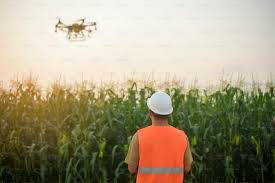Agriculture, the backbone of many economies, has undergone significant transformations over the years, thanks to the continuous evolution of technology. From traditional farming methods to the integration of digital solutions, the role of technology in agriculture has become increasingly indispensable. Among the various innovations, e-technology (electronic technology) has emerged as a powerful tool in helping farmers optimize their productivity, increase crop yields, and reduce costs.
In this article, we will explore how e-technology is revolutionizing farming, improving the lives of farmers, and contributing to sustainable agricultural practices.
1. Introduction to E-Technology in Agriculture
E-technology in agriculture refers to the use of electronic tools, systems, and applications that enable farmers to perform tasks more efficiently, access valuable information, and manage their farms in a more effective and sustainable way. These tools range from mobile applications and cloud-based solutions to sensors, satellite imagery, and drones.
The growing adoption of e-technology among farmers has led to improvements in various aspects of agriculture, including crop management, weather forecasting, irrigation, pest control, and market access. By providing farmers with real-time data and actionable insights, e-technology is helping them make informed decisions that improve their productivity and reduce resource wastage.
2. Key Benefits of E-Technology for Farmers
The integration of e-technology into agriculture offers numerous advantages. Some of the key benefits include:
a. Improved Crop Management
Crop management is one of the most crucial aspects of farming. E-technology helps farmers monitor the health of their crops, track growth patterns, and identify issues such as pests, diseases, or nutrient deficiencies. Through the use of mobile applications and sensors, farmers can receive real-time updates on their crops’ condition, enabling them to take timely actions to address problems.
Tools like smart irrigation systems use sensors to measure soil moisture levels and determine the optimal time for watering crops. This reduces water wastage, conserves resources, and improves crop yields.
b. Access to Weather Forecasting
Weather plays a vital role in farming, and unpredictable weather patterns can often lead to crop losses. With the help of e-technology, farmers can access accurate weather forecasts through mobile apps and online platforms. These forecasts provide vital information on temperature, humidity, rainfall, and other environmental factors that impact farming activities.
By using weather data, farmers can plan planting, harvesting, and irrigation schedules more efficiently. This leads to better crop planning, reduces the risk of crop failure, and improves overall productivity.
c. Efficient Pest and Disease Management
Pests and diseases are constant threats to agricultural crops. E-technology has introduced several solutions for detecting and managing pests and diseases. Through smart sensors, satellite imagery, and drone surveillance, farmers can identify early signs of pest infestations or disease outbreaks before they spread.
For instance, drone technology is being used to monitor large fields and gather data on crop health, detecting problems such as nutrient deficiencies or pest damage. This allows farmers to apply pesticides or other treatments more precisely, minimizing the use of harmful chemicals and reducing costs.
d. Precision Agriculture
Precision agriculture refers to using technology to monitor and manage crops more efficiently by considering factors such as soil composition, weather, and plant health. Through GPS technology, drones, and sensors, farmers can gather real-time data to make more accurate decisions about where to plant, how much water to use, and when to apply fertilizers.
By optimizing the use of resources, precision agriculture helps farmers reduce input costs and increase yields. This technology also contributes to sustainability by minimizing the use of chemicals and reducing environmental impact.
e. Market Access and Financial Services
E-technology has enabled farmers to connect with markets, buyers, and financial institutions more easily. Mobile applications allow farmers to directly access information about the demand for their crops, negotiate prices, and even sell their produce through online platforms. This eliminates the need for middlemen, ensuring that farmers receive fair prices for their products.
Moreover, e-technology facilitates access to financial services such as loans, insurance, and subsidies. Through mobile banking and financial apps, farmers can easily apply for loans, manage their finances, and receive financial assistance when needed.
3. Types of E-Technology Used in Agriculture
The role of e-technology in agriculture spans a wide array of digital tools and platforms. Here are some of the most common types of e-technology used by farmers:
a. Mobile Apps for Agriculture
With the rise of smartphones, mobile apps have become an essential tool for farmers. These apps provide access to a wide range of services, such as weather updates, pest control tips, market prices, crop management, and farming tutorials. Popular apps like AgriApp, Kisan Raja, and Farmers App enable farmers to make informed decisions about their crops and business.
For instance, apps like CropIn use data analytics and artificial intelligence to help farmers monitor their crops and manage their farms efficiently. These apps provide real-time insights that help farmers improve productivity and profitability.
b. Drones and Aerial Imaging
Drones are becoming an essential tool in modern farming. Equipped with high-resolution cameras and sensors, drones can capture aerial images of fields, allowing farmers to monitor crop health, detect pests, and identify irrigation issues. Drones can also be used for precision spraying, applying fertilizers, pesticides, and herbicides with greater accuracy, reducing chemical usage, and improving efficiency.
c. Internet of Things (IoT)
The Internet of Things (IoT) refers to the connection of devices through the internet, allowing them to communicate and exchange data. In agriculture, IoT devices like soil moisture sensors, weather stations, and smart irrigation systems provide real-time data that can help farmers monitor their crops and environment.
For example, IoT-based systems can automatically adjust irrigation levels based on soil moisture readings, ensuring that crops receive the right amount of water while conserving resources.
d. Artificial Intelligence and Machine Learning
Artificial intelligence (AI) and machine learning are playing a significant role in farming by helping farmers predict crop yields, identify pests, and optimize farm operations. AI-powered platforms can analyze large datasets and provide insights into crop diseases, pest infestations, and soil health, enabling farmers to take proactive measures before problems arise.
For example, IBM’s Watson Decision Platform for Agriculture integrates AI, weather data, IoT, and blockchain to help farmers make better decisions, increasing efficiency and reducing risks.
4. Challenges of Implementing E-Technology in Agriculture
Despite the numerous benefits, there are challenges to the widespread adoption of e-technology in farming, especially in developing countries. Some of these challenges include:
- Limited internet access in rural areas, which hampers the ability of farmers to access e-technology tools and information.
- High initial costs associated with purchasing advanced technology, which can be a barrier for small-scale farmers.
- Lack of digital literacy among farmers, making it difficult for them to fully utilize e-technology.
- Data privacy concerns, particularly when sharing farm data with third-party platforms or financial institutions.
5. Conclusion
E-technology is transforming the agriculture sector by providing farmers with the tools and information they need to improve productivity, reduce costs, and make more informed decisions. From mobile apps and drones to IoT devices and AI, these technological advancements are empowering farmers to overcome challenges and increase their farm yields.
As more farmers embrace e-technology, agriculture is moving toward a more efficient, sustainable, and profitable future. By investing in digital tools, education, and infrastructure, we can ensure that farmers worldwide can harness the full potential of e-technology and contribute to feeding the growing global population.


